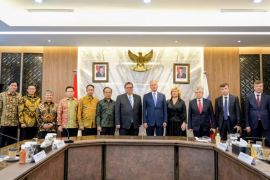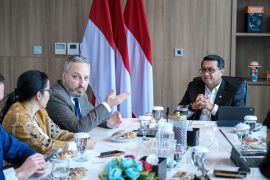However, the visit, which has been hailed by many as a great diplomatic move by Indonesia, has also drawn its share of skepticism and criticism, both from domestic and foreign commentators.
More than a week after the conclusion of President Jokowi’s peace mission, the situation in Ukraine has not changed for the better. There have been neither clear signs of Russia halting its attacks against Ukraine, nor do the prospects of peace between the two warring powers seem any closer. Some may say this is proof of the failure of Jokowi’s peace mission, but it will be wise to temper expectations of the visit in the first place. Achieving peace, or at the very least cessation of hostilities between Ukraine and Russia, while very important, is hard at this time. The current war situation in Ukraine is simply not ideal for enticing Russia and Ukraine to sit down at the negotiating table to discuss a peace plan.
Negotiating a peace settlement in a war is a lengthy process, with many challenges for the parties directly involved in the war or a neutral party acting as a mediator. One main obstacle is bringing the warring nations to the negotiating table. There are many factors that can influence warring nations, both the aggressor and the victim, in deciding to come together and negotiate an end to the conflict, chief among them is the level of bargaining leverage each nation holds over the other.
Bargaining leverage, in this case, can be understood as the ability of a warring nation, notably its leaders, to demand more favorable terms in the negotiation process. This leverage comes from the leaders’ ability to impose cost upon their opponent in the next battle should the negotiation fail, relative to the opponent’s ability to do the same to them. If a state cannot impose a significant cost upon its opponent in the next battle, then it must offer its opponent better terms than it would otherwise because the opponent is not deterred from fighting the next battle (Werner, 1998: 328). If this is the case, then leaders can opt to continue fighting and try to achieve more victories on the battlefield in order to gain more leverage over the opponent before they decide to enter negotiations.
The need to gain leverage to achieve a satisfactory negotiation outcome is particularly important for a nation’s leaders as they have to contend with domestic politics and public pressure that can potentially remove them from power. Each time a leader chooses to continue the war instead of settling it in a negotiation, the risk of removal from power by dissatisfied constituents increases. This is because war imposes hardships and suffering upon the population, and the longer it goes on, the more dissatisfied the population can become.
Related news: Jokowi's visits to Ukraine, Russia strategic for economic recovery
Likewise, when leaders choose to end a war, they may also face the risk of removal from constituents who are dissatisfied with the peace outcome. Settling raises the risk of removal because the end of the war provides constituents the opportunity to contrast the costs endured during the war with the benefits gained at its conclusion, and to reconsider the wisdom of participating in the war in the first place (Werner, 1998: 326). This means, if the end results of the war are deemed not equal to the sacrifices made, the public may blame their nation’s leader and decide to remove them from power.
How does this factor affect the situation in Ukraine? Both Russia and Ukraine will be subject to the “rules of negotiation,” as stated before. The more leverage one party has over its opponent during negotiations, the more it will be able to extract concessions. So, one may ask, how much negotiating leverage do Ukraine and Russia currently hold over each other? While this is difficult to determine accurately as the level of leverage is determined by many factors, as a rough estimate, the current battlefield progress in the war can serve as an indicator of the potential leverage held by Ukraine and Russia.
First, let us try to look at Russia’s possible leverage, reflected by its progress on the battlefield so far. Russia launched its invasion of Ukraine on February 24, 2022, roughly five months ago. In that time, Russia has succeeded in capturing around 20 percent of Ukraine’s territory—from areas near the eastern city of Kharkiv, all the way to the south, occupying a large portion of the coastline. But these gains have not come without significant costs. The first phase of the war in which Russia launched a hasty multi-front offensive to capture Kyiv and several other major cities, as well as to topple the Ukrainian government in the process, was a resounding failure. The Russian forces failed to meet their objectives and were forced to pull back after suffering heavy losses against the surprisingly fierce and effective Ukrainian resistance. As a result, Russia has shifted its efforts to the east with the lesser goal of capturing the entire Donbas region and liberating the so-called Luhansk and Donetsk People’s Republic (LPR & DPR).
In the east, Russian forces have made slow but steady gains by leveraging their decisive advantage in artillery to grind their way through Ukrainian defensive lines. Russia is estimated to be firing around 20 thousand 152-mm artillery shells per day, compared to Ukraine’s 6 thousand (Watling and Reynolds, 2022: 6). This overwhelming advantage in massed firepower has allowed the Russian army to compensate for its ongoing tactical and manpower deficiencies to capture ground in the heavily fortified Donbas region, albeit at an incremental pace.
While this approach has not been without its criticism for its indiscriminate use of firepower against civilian areas, as well as indicating a wider inability of the Russian army to execute mobile warfare, it has, at the very least, brought results for Russia. After weeks of bitter fighting, units of the Russian army, supported by LPR forces, captured the twin cities of Sievierodonetsk and Lysychansk, the final major Ukrainian settlements in the Luhansk province, on June 24 and July 3, respectively. The capture of the twin cities, and subsequently, the entire Luhansk province, has afforded Putin a significant political victory: he has achieved his first major objective laid out for the second phase of the war in Ukraine, which is the “liberation” of the so-called Luhansk People’s Republic. With this, Russia can now focus on the remaining objective of capturing Donetsk province, which will signify Russia’s total control over the Donbas region.
Related news: Russia-Ukraine war and the Indonesian peace mission
While the successes in Luhansk have been hailed as significant victories by Russia, they are, nevertheless, regarded as a local victory for the wider war in Ukraine. The capture of Luhansk has not dealt a crushing blow to Ukraine’s ability to continue the war. While the Ukrainian armed forces have been suffering heavy losses, estimated at 200 soldiers killed per day with more being wounded (BBC, June 2022), they are very much still in the fight. The loss of Luhansk has also not spelled doom for Ukraine’s control over the remaining Donbas region. Ukraine forces currently hold a strong defensive line, centered around the cities of Slovyansk, Kramatorsk, and Bakhmut, which will require weeks, or even months, of bitter fighting by Russian forces to overcome.
With that in mind, it is clear that the current situation on the ground does not afford Russia any decisive leverage that it can use against Ukraine in a peace negotiation. As said at the beginning of the article, negotiation leverage comes from the ability to impose cost upon an opponent so that it is deterred from fighting the next battle. Unfortunately for Russia, its current battlefield achievements and capabilities have not succeeded in deterring Ukraine from fighting the next battle, which, in this case, will be the battle for Donetsk. Instead, Ukraine is shown to be digging in at a new defensive line from Siversk to Bakhmut to meet the upcoming Russian offensive (Reuters, July 2022).
What this means for Russia, notably President Putin, is that if he enters into a peace negotiation right now, he will not have the means to extract sufficient concessions from Ukraine to satisfy his initial goals of the war, which are “denazification” or, as Western analysts call it, a regime change; demilitarization; and neutrality of Ukraine; as well as the surrender of the entire Donbas region to the separatist republics. On top of that, Russia will most likely also try to keep any territories it has gained outside the Donbas republics. Such harsh demands will almost certainly be rejected by Ukraine, especially when Russia holds no decisive leverage over it.
Meanwhile, if Putin settles for less, such as keeping his current territorial gains and perhaps gaining guarantees for a neutral Ukraine, something that President Zelenskyy showed he is willing to contemplate early in the war (BBC, March 2022), it may fail to satisfy his domestic audiences. As mentioned earlier in this article, negotiating a peaceful end to war always poses a risk of removal for a nation’s leader from constituents who are dissatisfied with the outcome. By settling for less, Putin opens himself up to a potential storm of criticism from the public, as well as his political allies and opponents. Nationalists in Russia may see him as a weak leader who quit the war too early at a time when Russia still holds many advantages over Ukraine. The general population may also be outraged when Russia has gained so little for the heavy price in lives and money that this war has brought upon Russian society. All these criticisms could seriously endanger Putin’s hold on power and could very well spell the end of his reign over Russia.
Related news: Jokowi readies to broker communication between Russia and Ukraine
It is evident that President Putin is aware of this danger as he has not shown any signs of quitting soon in Ukraine. Instead, even as the war in the Donbas is raging, there have been signs of Russia still holding to its maximalist war goals, as laid out on February 24 (ISW, July 2022). While continuing the war also poses a risk of removal for Putin, he has, at the very least, attempted to minimize it by ensuring strict information control over the population, as well as holding off on implementing a general mobilization, which is politically very risky as it will put the horrors of war at the forefront of Russian society when thousands of conscripted men inevitably return home in body bags. Instead, he has opted for covert mobilization by abolishing the age limit for fighting men and drastically increasing salaries to attract more recruits (DW, June 2022). This has also been accompanied by measures to mobilize the economy for a long war in Ukraine via laws that will ensure greater state control over private businesses and workers (Financial Times, July 2022). All in all, Putin is clearly in no hurry to end the war in Ukraine and will most likely hold off on entering any serious peace negotiations for the foreseeable future.
Now, what about Ukraine’s leverage? During the first phase of the war, Ukrainian forces performed far beyond the expectations of many, both in the West and in Russia. After exacting heavy losses to Russian spearheads and logistics around Kyiv, Chernihiv, Sumy, and Kharkiv, Ukraine was able to force Russia to pull back its forces. Unfortunately for Ukraine, the victory did not result in a decisive defeat for Russian forces as they simply refocused their attention on capturing Donbas instead.
In the second phase, Ukraine's forces have been facing greater difficulties with Russia increasingly relying on its massive advantage in artillery to blast its way forward in Donbas. The disadvantage is so overwhelming that senior Ukrainian military officials have estimated that Russia holds 10–15 times more artillery compared to Ukraine (The Guardian, June 2022). The disadvantage is also being felt in terms of artillery ammunition. Ukraine is simply running out of 152 mm rounds used by the Soviet-era artilleries that comprise the majority of its inventory. With its defense industry in tatters due to Russian bombings, as well as the limited number of 152 mm rounds among Western allies, Ukraine could very well end up not having ammunition for the majority of its howitzers.
While the situation looks grim for Ukraine in Donbas and beyond, it still does not indicate that it has lost decisive leverage against Russia. While it is true that Ukraine is suffering heavy losses, both in manpower and weapons, it is still not out of the fight. In fact, Ukraine currently is still capable of contesting Russian offensives in Donbas as well as launching local offensives around Kharkiv and Kherson with varying degrees of success. Retaining this ability to fight the next battle affords Ukraine sufficient leverage to withstand any steep Russian demands during a peace negotiation.
Another factor that lends to Ukraine’s ability to continue the fight is unwavering Western support, especially in terms of armament supplies since the beginning of the war. Advanced anti-tank guided missiles (ATGM) supplied by the West, such as the US Javelin and British NLAW (Next generation Light Anti-tank Weapon), helped slow down Russian armored offensives early in the war, allowing them to be finished off by artillery. Even five months into the war, the Western arms support for Ukraine has not shown signs of slowing, with shipments now including heavy weapons such as tanks and advanced long-range artillery systems like the French CAESAR, German Pzh 2000, and the American M777 and HIMARS rocket system.
The presence of this advanced artillery system has brought noticeable effects on the battlefield, allowing Ukrainian forces to hit targets farther with pinpoint accuracy. The string of attacks against Russian ammo dumps and command post this past week has been attributed to the use of the American-supplied HIMARS rocket system, which allowed Ukraine to hit targets 70 km away with high accuracy. Unfortunately for Ukraine, while these weapons have brought positive effects on the battlefield, their current numbers are insufficient to strategically alter the balance of power on the battlefield. The current eight HIMARS that Ukraine has and the four more that America has pledged to supply (CNBC, July 2022) are far below the 60 launchers the Ukrainian Presidential Adviser, Oleksiy Arestovych, has said Ukraine needs to stop Russia’s offensive (The Guardian, June 2022).
With no decisive advantage over Russia on the battlefield, Ukraine will be hard-pressed to demand any deep concessions from Russia, namely the full withdrawal of Russian forces from the entirety of Ukraine (The Washington Post, May 2022). Instead, if Ukraine enters negotiations now, it may be forced to offer concessions to Russia, even if such concessions are relatively minor. This is because while Russia also does not hold any decisive leverage over Ukraine, it is still negotiating from a position of strength as it has occupied a fifth of Ukraine’s territory, and is currently strangling Ukraine’s economy with blockades in the Black Sea. While those advantages may not be strong enough to force Ukraine to capitulate to Russia’s full demands, they may still be enough to force some concessions out of Ukraine. Even if both parties simply agree to a ceasefire on the current line of contact, it will still be a loss for Ukraine as Russia will gain control over a significant chunk of its territory.
All in all, there is no pressing need for President Zelenskyy to enter serious negotiations with Russia to end the war right now as it will not bring a favorable outcome for Ukraine. There is also no pressing need to seek an end to the war right now as Ukraine’s armed forces, while bloodied, are still very much capable of countering the Russian offensive.
Related news: Indonesia only seeks solutions on conflict, supply disruption: Jokowi
This is why achieving peace through negotiations in Ukraine, at this time, will be very difficult to attain. Neither Russia nor Ukraine has much incentive to seriously negotiate an end to the war right now as none holds decisive leverage. And, neither Russia nor Ukraine is pressed to end the war anytime soon. While both countries have suffered heavy losses, they have yet to exhaust their respective combat capabilities. Without decisive leverage, both sides will be forced to settle for less if they insist on negotiating an end to the war, which will be politically risky for both Putin and Zelenskyy.
As a closing, the slim chance of peace between Russia and Ukraine at this time should not deter any party that wishes to promote peace between the two warring nations. Peace missions like the one recently embarked upon by Indonesian Widodo, while less likely to bring immediate results, can still play a crucial role in bringing the importance of peace to the attention of the leaders of the two warring nations. Peace is a gradual process and can sometimes require years of mediation and back-channel negotiations to bear fruit. But, it is always a worthwhile endeavor, as the alternative to peace is war, and there is no worse outcome than that.
*M. Teguh Ariffaiz Nasution is a graduate of the University of Indonesia's International Relations Department.
The views and opinions expressed on this page are those of the author, and do not necessarily reflect the official policy or position of the ANTARA News Agency.
Related news: G20 nations express concern over food, energy price surge
Related news: Russia lauds Indonesia's role at international forums
Copyright © ANTARA 2022












